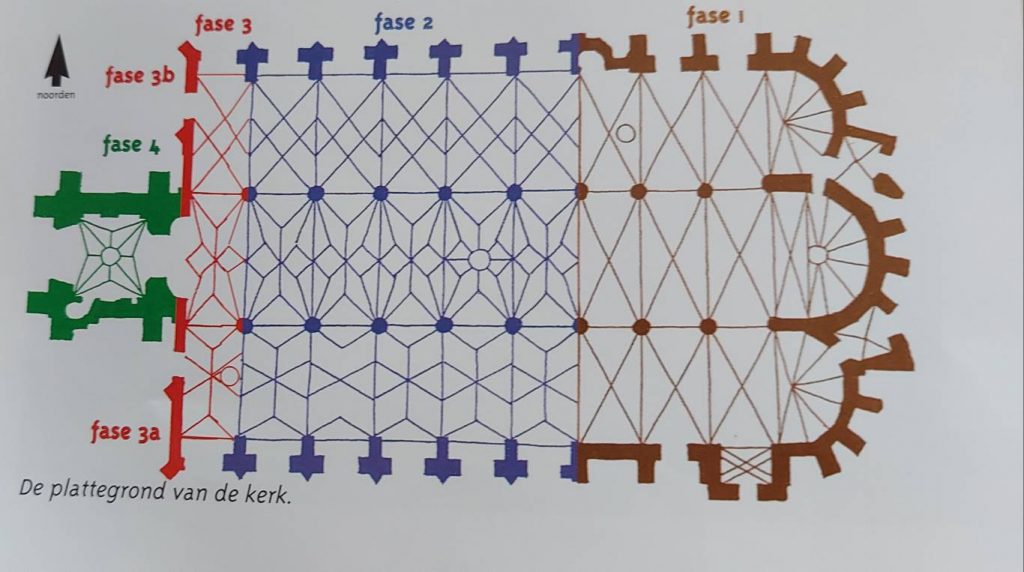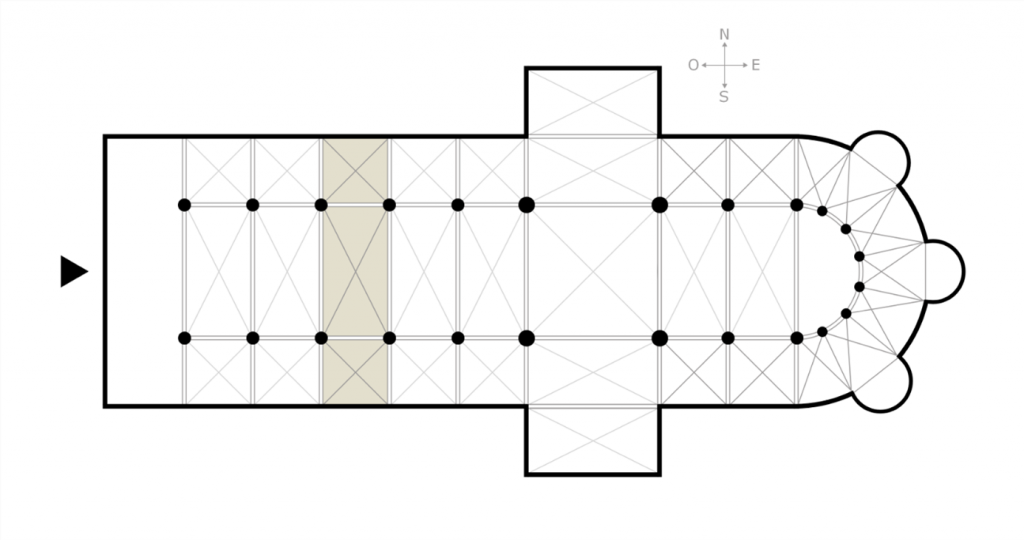Welk deel van de kerk is het eerst gebouwd?
Die oude kerk die hier vroeger stond, is in 1500 helemaal gesloopt, alleen het nieuwe koor uit 1456 blijft staan. Dan begint de tweede bouwfase: de resterende traveeën, dat wil zeggen, tot en met de voorlaatste travee. Die wordt voorlopig afgesloten met een muur. In 1512 wordt de kerk opnieuw gewijd. Meer over de verschillen tussen de eerste en de tweede bouwfase.
De toren
Tot 1528 stond er nog de oude toren. Die is in dat jaar gesloopt. Maar voor die tijd is de 9de travee gebouwd. De toren is de laatste bouwfase. Deze start waarschijnlijk kort na 1528 maar stopt alweer vrij snel.
Latere aanbouwen
De plattegrond van de kerk is daarna niet meer ingrijpend veranderd. Wel zijn er in de loop van de eeuwen nog diverse aanbouwen tegen de kerk aangezet. Zo staan er tot 1883 aan de zuidzijde van de toren een vleeshuis en aan de noordelijke hoek een huis waar ooit een kruidenier gevestigd was. In de 19de eeuw is achter de kerk een sacristie gebouwd.
Traveeën
Een travee is de ruimte tussen twee opvolgende steunpunten in de lengterichting van het gebouw.
Verschillen tussen de eerste en de tweede bouwfase
De verschillen tussen de eerste en de tweede bouwfase zijn zowel van binnen als van buiten duidelijk zichtbaar.
Buiten: De steunberen van de hele kerk staan op 1 lijn. De buitenmuren uit de eerste bouwfase staan zover mogelijk naar binnen; later werden de muren zover mogelijk naar buiten geplaatst.
Binnen zie je het verschil in de gewelven. Het oudste deel heeft eenvoudige kruisgewelven; het jongere deel ruit-; ster-; of netgewelven. De oudste pijlers hebben eenvoudige kapitelen, de jongere pijlers worden bekroond met – met pompebladeren – versierde kapitelen.
Building phases
Which part of the church was built first?
The old church that used to stand here was completely demolished in 1500, with only the new choir from 1456 remaining.
Then the second building phase begins: the remaining bays , that is, up to and including the penultimate bay. This is provisionally closed with a wall. In 1512, the church is consecrated anew. More on the differences between the first and second construction phases .
The tower
Until 1528, the old tower still stood there. It was demolished in that year. But before then, the 9th bay was built. The tower is the last phase of construction. It probably starts shortly after 1528 but is stopped quite soon afterwards.
Later additions
The floor plan of the church did not undergo major changes thereafter. Over the centuries, however, several annexes were added to the church. For example, until 1883, there was a meat house on the south side of the tower and a house at the northern corner that once housed a grocery shop.
A sacristy was built behind the church in the 19th century.
Bays
A bay is the space between two successive supports in the longitudinal direction of the building .
Differences between the first and second construction phase
The differences between the first and second phases of construction are clearly visible from both inside and outside.
Outside: The buttresses of the whole church are aligned. The outer walls from the first construction phase are as far inward as possible; later, the walls were placed as far outwards as possible.
Inside, you can see the difference in the vaults. The oldest part has simple cross vaults; the younger part diamond, star or net vaults. The oldest pillars have simple capitals; the younger pillars are crowned with capitals decorated with pump leaves.

